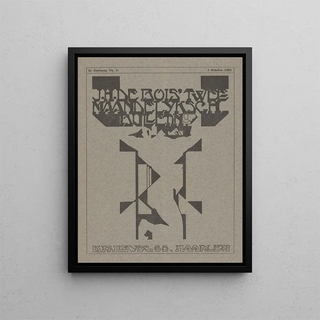Art print | Seated woman on the last page of the bi-monthly Bulletin J. H. de Bois - Reijer Stolk


View from behind

Frame (optional)
Femme sitting art print on the last page of the bi-monthly Bulletin J. H. de Bois - Reijer Stolk – Captivating introduction
The Femme sitting art print on the last page of the bi-monthly Bulletin J. H. de Bois - Reijer Stolk is a piece that invites contemplation and reflection. In this work, the artist captures a moment of tranquility, where a woman, lost in her thoughts, appears suspended between the past and the present. The choice of subject, a woman sitting, evokes a palpable intimacy, while the overall composition immerses us in a universe filled with serenity. The soft light bathing the scene and the delicate colors create a warm, almost nostalgic atmosphere, transporting the viewer into a silent dialogue with time.
Style and uniqueness of the work
Reijer Stolk's style is distinguished by a subtle and refined approach, blending elements of realism and impressionism. In this piece, the woman is depicted with particular attention to detail, from the folds of her dress to the delicate expressions on her face. Every element is carefully considered to contribute to the overall harmony of the composition. The color palette chosen by the artist, dominated by soft tones, enhances this contemplative atmosphere. The blurred backgrounds, suggesting a depth of field, add an extra dimension to the work, allowing the eye to wander through the nuances and shapes. This stylistic singularity gives the piece a timeless quality, echoing universal emotions.
The artist and his influence
Reijer Stolk is an artist whose work has often been underestimated, but who deserves special attention for his ability to capture the essence of everyday life with a unique sensitivity. Influenced by the great masters of painting, Stolk has developed a style that is uniquely his own, combining technical finesse with emotional depth. His interest in intimate scenes, such as that of the sitting woman, reflects his desire to highlight moments of life often overlooked. The influence of impressionism is evident in his use of light and color, while his realistic approach recalls the masters of the past. By rediscovering his work, one can appreciate the way in which

Matte finish

View from behind

Frame (optional)
Femme sitting art print on the last page of the bi-monthly Bulletin J. H. de Bois - Reijer Stolk – Captivating introduction
The Femme sitting art print on the last page of the bi-monthly Bulletin J. H. de Bois - Reijer Stolk is a piece that invites contemplation and reflection. In this work, the artist captures a moment of tranquility, where a woman, lost in her thoughts, appears suspended between the past and the present. The choice of subject, a woman sitting, evokes a palpable intimacy, while the overall composition immerses us in a universe filled with serenity. The soft light bathing the scene and the delicate colors create a warm, almost nostalgic atmosphere, transporting the viewer into a silent dialogue with time.
Style and uniqueness of the work
Reijer Stolk's style is distinguished by a subtle and refined approach, blending elements of realism and impressionism. In this piece, the woman is depicted with particular attention to detail, from the folds of her dress to the delicate expressions on her face. Every element is carefully considered to contribute to the overall harmony of the composition. The color palette chosen by the artist, dominated by soft tones, enhances this contemplative atmosphere. The blurred backgrounds, suggesting a depth of field, add an extra dimension to the work, allowing the eye to wander through the nuances and shapes. This stylistic singularity gives the piece a timeless quality, echoing universal emotions.
The artist and his influence
Reijer Stolk is an artist whose work has often been underestimated, but who deserves special attention for his ability to capture the essence of everyday life with a unique sensitivity. Influenced by the great masters of painting, Stolk has developed a style that is uniquely his own, combining technical finesse with emotional depth. His interest in intimate scenes, such as that of the sitting woman, reflects his desire to highlight moments of life often overlooked. The influence of impressionism is evident in his use of light and color, while his realistic approach recalls the masters of the past. By rediscovering his work, one can appreciate the way in which






